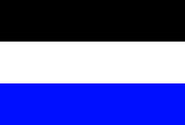| This page uses Creative Commons licensed content from Wikipedia. (view authors) |
The national flag of the Kingdom of Belgium is made of a vertical tricolor of black, white, and red, all of which are colors that were taken from the coat of arms of the Duchy of Brabant, and the vertical design may be based on the flag of France. It first appeared when riots kicked off the beginning of the Belgian Revolution, insurgents replaced the flag with one of red, black and yellow stripes, which bore a resemblance to the flag used during the Brabant Revolution of the 18th century. The flag that is still flown to this day was adopted on October 12, 1831. The red represents the red lion of Hainaut, Limburg and Luxembourg. The yellow represents the yellow lion of Brabant. Finally, the black stripe represents the black lion of Namur and Flanders. When flown, the black band is nearest the pole (at the hoist side). It has the unusual proportions of 13:15.
Historical Flags[]
Subdivisions[]
Belgium has two types of first-level subdivisions. Administratively, the country is divided into three regions: Flanders, Wallonia and the Brussels-Capital Region; the first two are further divided into five provinces each.
It also has three language-based communities. Two of them, the Flemish and French Communities, occupy mostly the same geographic area as the Flemish and Walloon Regions respectively, and use the same flags; Brussels is part of both communities. The third is the German-speaking Community in the east of the country; it is administratively part of the Walloon province of Liège.
Flag redesigns[]
| Europe V • T |
|---|
Disputed states
Dependencies and overseas territories
|











